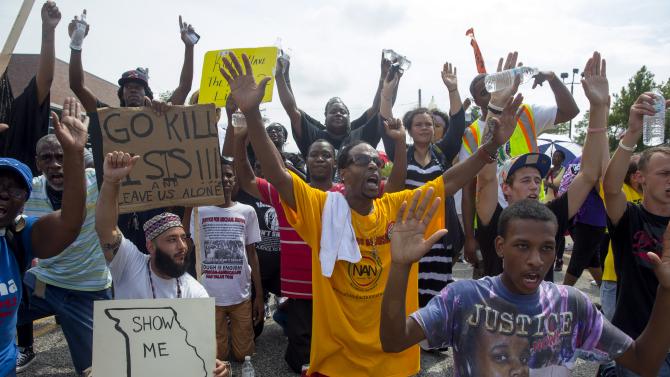
Why hold out for a hero when you can save yourself?
When protests erupted in Ferguson, Mo., after the police shooting of unarmed black teenager Michael Brown, it wasn’t the black establishment of the St. Louis bedroom community taking it to the streets; it was Brown’s peers. Kids in their teens. Young adults in their 20s. Some knew him. Others did not. But what they all had in common was that they’d had enough of waiting for things to get better.
For them, Brown’s death could not be in vain. Now was the time for organization, for action.
With the rallying cries of “Hands up, don’t shoot!” and “Our lives matter,” young people of color are the real leaders emerging in the aftermath of the shooting in Ferguson. Their efforts were born out of fear and anger over police overreach and brutality, and the faces of those efforts are fresh, determined, youth-led groups using traditional organizing and nontraditional tools such as social media. And these activists linking up for the same goal, whether they’re on the ground in Ferguson or in front of their laptops halfway across the country.
Meet the faces of today’s fight for equality.
#NMOS14/#SEPT6CTA

Michelle Watson Taylor first suggested, over Twitter, that there should be a moment of silence for those killed in police brutality. But Taylor, known online as Feminista Jones, didn’t want to lead the endeavor, instead encouraging those inspired by the idea to become leaders of the effort. Through Twitter, she reached out to individuals across the country who on Aug. 10 became organizers, doing the heavy lifting to create gatherings in their cities. Volunteers created logos, found meeting places and promoted the event. The result? A National Moment of Silence (#NMOS14) on Aug. 14 that led to activists hosting vigils in 90 U.S. cities for those killed by police officers.
What’s next? #NMOS14 is steadily evolving, and largely online. Sept. 6 was designated a day of action for groups fighting police brutality, encouraging groups and individuals to host teach-ins, rallies and town hall meetings to help create the next steps in the movement.
Hands Up United
Hands Up United, a coalition of young, emerging organizers working together to fight police brutality, was born out of the Ferguson protest, it’s name taken from Michael Brown’s reported final posture—hands raised in surrender. The coalition is calling for an end to “state sponsored violence, including the excessive use of force by law enforcement.” The group also calls for an end to “racial bias and white supremacy in all its forms.”
Hands Up United is seeking the demilitarization of police departments and police accountability to the communities in which they work, and they want police departments to racially reflect the neighborhoods they police and for there to be federal investigation and oversight in certain cases.
Ohio Student Association
Michael Brown’s death in Ferguson and that of Eric Garner in Staten Island, N.Y., also at the hands of police, led to massive protests, but in the middle of this was yet another police killing of a black man, this time the shooting of John Crawford III in a Wal-Mart in Beavercreek, Ohio. His alleged last words to the police were that the toy air rifle he was holding—one sold at Walmart—was not real. The Ohio Student Association, a collaborative of students from high school to graduate school fighting for equal access to high-quality education for all, has joined the campaign against police brutality. Along with standing in solidarity with protesters in Ferguson, the association is demanding the release of store surveillance video of the Crawford shooting.
Dream Defenders
Michael Brown’s death was hard for a group such as Dream Defenders to take, if only because they were born of similar circumstances—their group was formed out of the killing of Florida teen Trayvon Martin. Seeing a common cause, Dream Defenders went to Ferguson to join and help organize the protests.
Dream Defenders Executive Director Phillip Agnew was in Ferguson when police raided a church-related school building that he and other organizers were using as a haven. And in Miami, eight members of Dream Defenders were arrested when they marched on the U.S. attorney’s office. The group was protesting inaction over another police-involved death, that of tattoo artist Israel Hernández-Llach.
Million Hoodies
Like Dream Defenders, Million Hoodies emerged out of the killing of Trayvon Martin. Since Ferguson, Million Hoodies and its deputy director, Dante Barry, have been on the ground helping protest organizers in Missouri while also pushing a Twitter campaign calling on Sen. Richard J. Durbin (D-Ill.) and the Senate Judiciary Committee to hold a hearing on police brutality.
Black Youth Project 100
Consisting of 100 influential young activists from across America, the Black Youth Project is seeking strategic solutions and mobilization for communities of color. With a focus on research, amplifying the voices of young African Americans and engaging in direct action on the ground, it wasn’t surprising that some members of the BYP 100 went to Ferguson to organize. The group also released a report highlighting the criminalization of black and brown communities.















